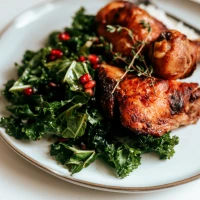Food is not just about sustenance; it’s a symphony. Each ingredient harmonizes with another, creating a masterpiece of taste and health. Today’s culinary scene is a testament to the balance between hearty meats and vibrant vegetables. The debate between meat enthusiasts and veggie lovers is longstanding, but what if we don’t have to choose? This article endeavors to reveal the secrets of crafting a balanced meal with the tenderness of chicken thighs and the nutritional powerhouse of garden-fresh vegetables.
Understanding the components is critical, starting with a common query: how many chicken thighs in a pound? Knowing the answer steers the journey to culinary balance. However, it’s the integration with fresh vegetables that transforms the ordinary to extraordinary. So, let’s embark on a flavorful journey from the simplicity of chicken thighs to the complexity of a veggie delight.
Chicken Thighs: The Unsung Heroes of Poultry
Chicken thighs often lurk in the shadow of their popular counterpart, the chicken breast. Yet, these cuts deserve recognition for their depth of flavor and succulence.
The Meat of the Matter: Quantity and Quality
A fundamental question often surfaces in kitchens worldwide: “How many chicken thighs in a pound?” Generally, one pound consists of approximately four to five boneless thighs or two to three bone-in thighs. However, this can vary based on the size of the thighs and whether they’re skinless or skin-on.
Selecting the Best
To ensure you’re infusing your meals with quality:
- Look for thighs that have a plump shape and a uniform size for even cooking.
- The skin, if present, should be unblemished and without excess fat.
- Above all, the color should be a healthy pink, indicating freshness.
Nutrition Nuggets: The Power of Chicken Thighs
Underline the importance of including chicken thighs in your diet. They’re not just about taste:
- Rich in Protein: Vital for muscle growth and repair.
- Loaded with Vitamins: Such as B6, supporting energy metabolism.
- Minerals Galore: Iron and zinc make a strong appearance.
Preparing for Perfection
When it comes to preparing chicken thighs:
- Pat the chicken dry for optimal skin crispiness.
- Season generously to penetrate the muscular fibers.
- Preheat your cooking medium, whether it’s a skillet or an oven, to ensure a perfect sear.
Cooking to Temperatures Triumph
Perfectly cooked chicken thighs aren’t just about flavor; they’re also about safety. Poultry should reach an internal temperature of 165°F. A digital meat thermometer becomes invaluable in this quest. Cooking times may vary, but a general rule of thumb is 25-30 minutes at 400°F for bone-in thighs in the oven, slightly less for boneless.
The Vegetable Vanguard: Elevating Meals with Greens
Vegetables are the backbone of a balanced diet, providing essential nutrients, fiber, and a burst of color to your plate.
The Bounty of Benefits
Highlight the importance of vegetables with their diverse offerings:
- Antioxidants: To fight off free radicals.
- Dietary Fiber: Essential for digestive health.
- Low in Calories: Aiding weight management efforts.
Pairing Prowess: Chicken meets Vegetables
Unlock the secret to pairing chicken with vegetables:
- Textural Contrast: Combine the tenderness of chicken with the crunch of fresh veggies.
- Flavor Fusion: Experiment with herbs and spices to marry the flavors beautifully.
- Color Palette: Aim for a rainbow on your plate to maximize nutrient diversity.
Seasonal Selections: Harvesting the Best
Choose vegetables that are in season:
- For spring, think tender asparagus and sweet peas.
- Summer shines with bell peppers and zucchini.
- Autumn brings forth squashes and sweet potatoes.
- Winter is perfect for hardy greens and brussels sprouts.
The Perfect Plate: Creating Harmony between Chicken Thighs and Vegetables
Combining chicken thighs with vegetables is an art. It’s balancing flavors, textures, and nutrition to create a meal that satisfies the soul and the body.
Crafting the Dish: Techniques to Try
Experiment with these methods for an enthralling dining experience:
- Roasting: Roast chicken thighs atop a bed of root vegetables for a one-pan wonder.
- Stir-Frying: Swiftly cook sliced chicken thighs with an array of vibrant veggies for a healthy stir-fry.
- Grilling: Achieve smokiness by grilling chicken and skewered vegetable kabobs.
Seasoning Strategically
Strike a balance with herbs and spices:
- Use rosemary and garlic to add a Mediterranean twist.
- Embrace boldness with a touch of smoked paprika or cumin.
- For a fresh kick, incorporate cilantro or parsley.
Presentation: The Final Touch
The way to the heart is through the stomach, and the eyes have their role:
- Arrange with intention, focusing on making the vegetables as enticing as the chicken.
- Add a drizzle of olive oil or balsamic glaze for an extra flair.
- Garnish with fresh herbs to heighten the senses.
Conclusion: A Tailored Taste Journey
Achieving harmony between chicken thighs and vegetables resides in the delicate balance of flavors, textures, and nutrition. Each meal is a personal canvas to express creativity and to nourish the body. From understanding the basics, like how many chicken thighs in a pound, to mastering the art of vegetable selection, the road to a balanced plate is an exciting culinary adventure. Embrace the variety and let the fusion of chicken thighs and vegetables lead you to a healthier, more flavorful lifestyle.










